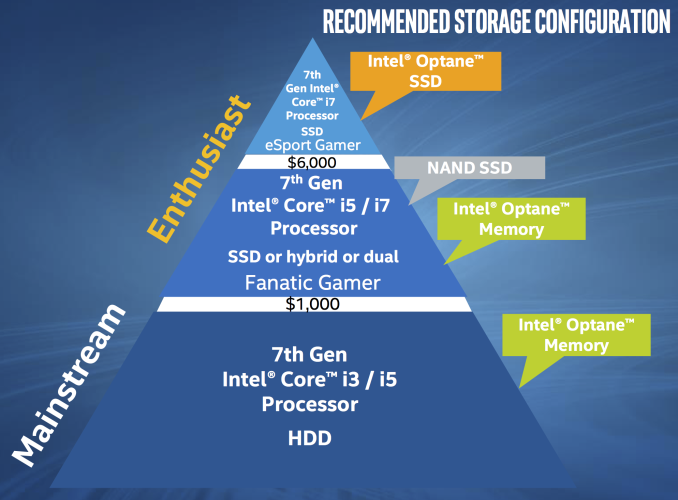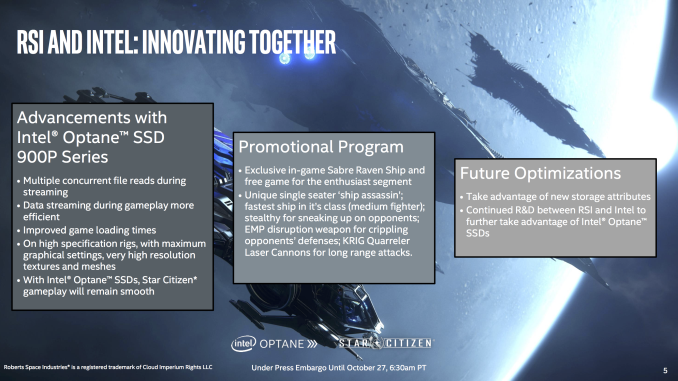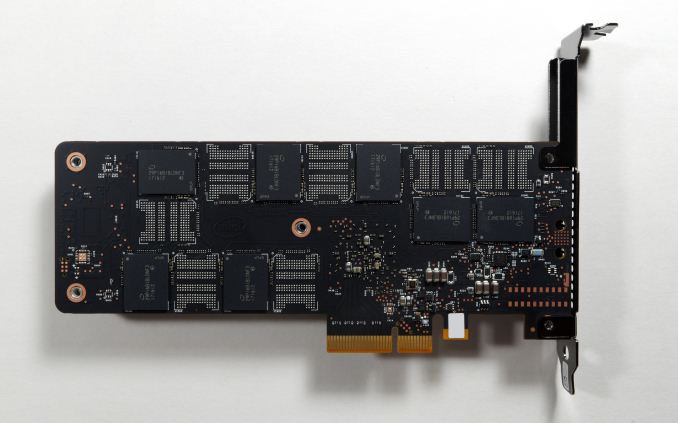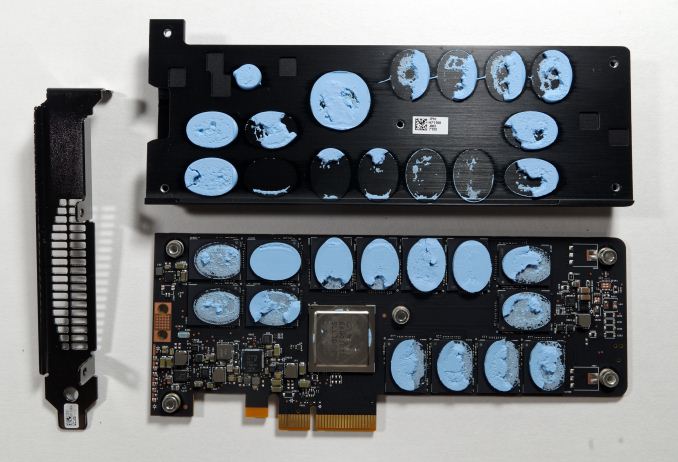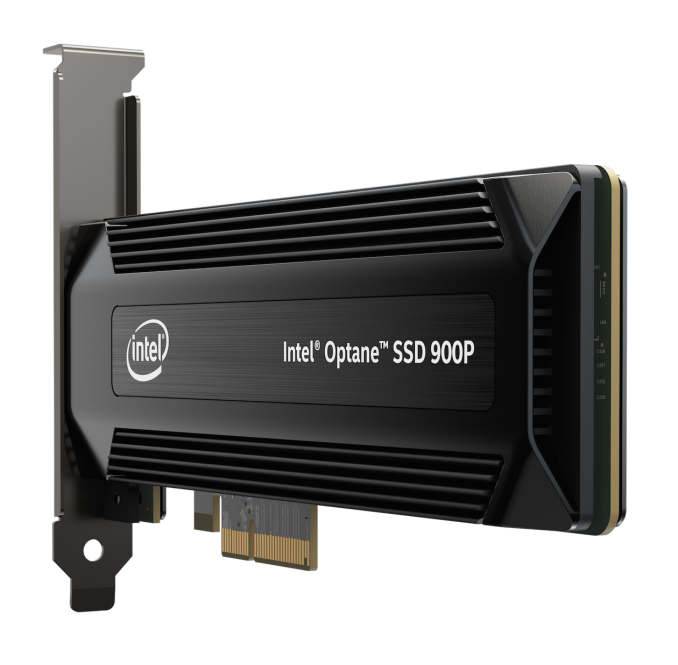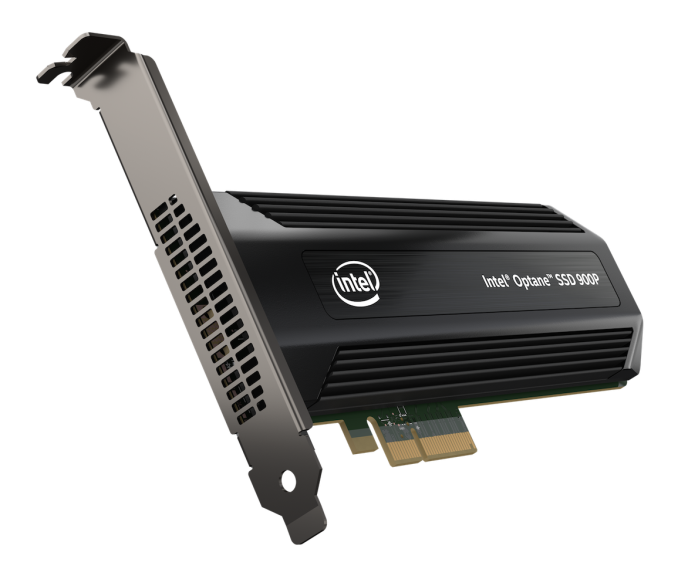
Whenever Intel develops a new generation of SSDs based entirely on in-house technology, the result is usually a product that turns heads. Several times, Intel has set a new standard for SSD performance, starting with its original X25-M. Their most recent shake-up of the consumer SSD market was the Intel SSD 750, the first consumer NVMe SSD. Such significant releases don’t happen every year, and in the intervening years Intel’s competitors always catch up and surpass Intel.
However this year’s revolution from Intel will be very hard for the competition to match anytime soon. All of Intel’s previous record-setting SSDs have relied on the drive’s controller to stand out from the crowd. This time, Intel’s advantage comes from the storage medium: its 3D XPoint memory technology, a new nonvolatile memory that offers much higher performance than flash memory.
The new Intel Optane SSD 900P is a premium NVMe PCIe SSD offering the highest level of performance, with a moderate capacity. The Optane SSD 900P is intended for high-end desktop systems and workstations with very disk-heavy workloads. The Optane SSD 900P isn’t for everyone and won’t be displacing any existing products – it exists alone in a new product tier, with prices that are more than twice what the fastest flash memory based SSDs are selling for.
Optane is Intel’s brand name for products featuring 3D XPoint memory. The Intel Optane SSD 900P is actually the third Optane product to be released, but it’s the first family member to go after the high end consumer market segment. The Intel Optane Memory M.2 drives released earlier this year have capacities far too small for general-purpose storage use and instead have been marketed for use as a cache device to be paired with a mechanical hard drive. Intel’s caching strategy works and can bring a hard drive’s responsiveness up to the level of mainstream SSDs, but it has downsides. The Optane Memory caching requires a few extra steps to setup, and the caching software will only run on Intel platforms introduced this year: Kaby Lake or newer.
The Optane SSD DC P4800X is Intel’s flagship enterprise SSD, and it is priced accordingly—putting it far out of reach of consumer budgets, and even with a price tag of over $ 1500 for 375GB it has been quite difficult to acquire. In the enterprise storage market, the P4800X has been highly sought after, but it isn’t appropriate for all use cases and is not a threat to the many enterprise SSDs that prioritize capacity over performance and endurance.
The Optane SSD 900P will still cause some sticker shock for consumers expecting prices in line with M.2 PCIe SSDs, but it is acceptable for the kinds of machines that might be packing multiple GPUs or 10+ CPU cores. The Optane SSD 900P probably wouldn’t be the only drive in such a system, but it would work well as a blazing fast primary storage device.
| Intel Optane SSD 900P Specifications | ||
| Capacity | 280 GB | 480 GB |
| Controller | Intel SLL3D | |
| Memory | Intel 128Gb 3D XPoint | |
| Interface | PCIe 3.0 x4 | |
| Form Factor | HHHL Add-in card or 2.5″ 15mm U.2 |
HHHL Add-in card |
| Sequential Read | 2500 MB/s | |
| Sequential Write | 2000 MB/s | |
| Random Read IOPS | 550k | |
| Random Write IOPS | 500k | |
| Power Consumption | 8W Read 13W Write 14W Burst 5W Idle |
|
| Write Endurance | 10 DWPD | |
| Warranty | 5 years | |
| Recommended Price | $ 389 ($ 1.39/GB) | $ 599 ($ 1.25/GB) |
The Intel Optane SSD 900P is initially launching with 280GB and 480GB capacities. Both sizes will be available as PCIe 3.0 x4 half-height half-length add-in cards, and the 280GB model is also available as a 2.5″ U.2 drive. Higher capacities may be added later, but Intel isn’t promising anything yet. The sequential transfer speeds are nothing special for a NVMe SSD these days—Samsung’s 960 PRO can hit much higher read speeds and slightly higher write speeds. The random read and write IOPS are far higher than any consumer SSD has offered before.
Intel’s specifications for power consumption show one big reason why the Optane SSD 900P is a desktop-only product. Laptops are not equipped to supply up to 14W to a SSD, and they usually aren’t equipped to cool a drive that idles at 5W instead of 50mW. The level of performance offered by the Optane SSD 900P cannot currently fit within the power budget or space constraints of a M.2 card.
The five year warranty Intel offers is typical for a high-end SSD in today’s market, but doesn’t compare to the 10 year warranty that Samsung’s flagship 850 PRO SATA SSD offers. On the other hand, the 10 drive writes per day write endurance rating is far higher than most consumer SSDs get; 0.3 DWPD is more typical.
The Intel Optane SSD 900P starts shipping worldwide today, and here is our review of the 280GB version.
With a price per GB a little over twice that of the the fastest flash-based consumer SSDs, the Optane SSD 900P is an exclusive high-end product. For most desktop usage, drives like the 960 PRO are already fast enough to make storage no longer a severe bottleneck. The most noticeable delays due to storage performance on a 960 PRO are when moving around large files, and the Optane SSD doesn’t offer any significant improvement to sequential transfer speeds. Random writes can be a challenge for flash-based SSDs, but volatile write caches and SLC caches allow them to handle short bursts with very high performance.
The unprecedented random read performance of the Optane SSD 900P is its biggest strength on paper, but not one that will often lead to a proportional speedup in overall application performance. Too many programs and filesystems are still designed with mechanical hard drive performance in mind as the baseline, and further increases to SSD performance serve mainly to shift the bottlenecks further onto the CPU, RAM, network, and even the user’s own reaction time.
The scenarios where a drive like the Optane SSD 900P can offer meaningful and worthwhile performance improvements can be broadly categorized as as situations where the Optane SSD can help with one of two problems:
1. Storage is too slow
About the only time a desktop could challenge the sequential access performance of a high-end PCIe SSD (based on flash or 3D XPoint) is when dealing with high resolution uncompressed video. The Optane SSD doesn’t help much here because of its limited capacity, and the PCIe 3 x4 link itself is a bottleneck at the highest refresh rates and bit depths. For video work, flash-based SSDs are definitely a better choice, and RAID arrays of cheaper SATA SSDs may be a better option than PCIe SSDs. Desktop workloads that require extremely high sustained random write performance are very rare, and SLC caching on a flash-based SSD nicely takes care of most realistic quantities of random writes.
That said, there are some situations where higher random read performance can be quite noticeable. Searching through a large volume of data is a common case, such as searching through a video, but it usually presents enough opportunities for parallelization that the drive’s queue depth will climb up to the range where flash-based SSDs come close to the Optane SSD. Game level load times can in theory benefit greatly from faster read speeds, but in practice decompressing the assets after loading them into RAM quickly becomes the bottleneck. Most of the other situations where the performance advantage of the Optane SSD will really help are better described as a different kind of problem:
2. RAM is too small
In the workstation market, there are abundant examples of compute tasks with a memory working set that doesn’t fit in RAM. Almost any simulation or rendering task will have a parameter for mesh density or particle count that can very quickly scale the memory requirements from a few GB to tens or hundreds of GB. An Optane SSD is far slower than four to eight channels of DDR4, but 16GB DIMMs are least 6-7 times more expensive per GB than the Optane SSD 900P, and putting more than 128GB of DRAM in an ATX motherboard is even more expensive.
Intel PR provided an example of using SideFX Houdini to render a high-resolution animation that included a 1.1 billion particle water simulation. Their test used a machine with a 10-core CPU and 64GB of RAM, and compared the 512GB Samsung 960 PRO against the 480GB Optane SSD 900P. The total memory requirements (DRAM+swap) of the rendering job were not disclosed, but the resulting 2.7x speedup is very plausible for a task that absolutely hammers the swap device. With a sufficiently high thread count to keep the queue depth high, that margin could be narrower (especially with the fastest 2TB 960 PRO), but then context switch overhead would become problematic. With the Optane SSD 900P, the random read latency is low enough that it would be hard to host more than two swap-limited threads per core without context switch overhead wasting more time than waiting on the SSD.
Even though gaming isn’t the ideal workload for the Optane SSD 900P to show off its performance, Intel is marketing the 900P to gaming enthusiasts. They’re bundling a code for the game Star Citizen with the 900P, and including a new in-game spaceship variant as an exclusive item for Optane SSD customers. Intel has partnered with Star Citizen developer Roberts Space Industries (RSI) to hold a launch event for the 900P at CitizenCon 2017 today, which they are streaming live on Twitch and YouTube. Attendees will have the chance to playtest the Intel-exclusive Sabre Raven ship, but it is still undergoing final QA and will not be immediately available to Optane SSD 900P customers. The web page for redeeming the Star Citizen game code had not gone live as of the time of writing, so I was unable to attempt any testing with the game. (ed: I remember when AMD was offering a Star Citizen bundle in 2014 as well. The game still hasn’t shipped.)
At the media briefing for the 900P, an RSI representative said they are exploring ways to optimize the Star Citizen experience on Optane SSDs, but not many specifics were provided. One approach under consideration is using less compression for some game assets, freeing up CPU time but relying on high storage performance. It didn’t sound like this work was close to release. In the game’s current state, RSI claims they’ve seen load times improve by 20-25%, but they didn’t specify what other storage device they were comparing against.
Intel’s strategy for developing the Optane SSD 900P is the same they used for the SSD 750 in 2015. Both products are consumer-oriented derivatives of the flagship enterprise SSD of their time. As with the SSD 750, this has resulted in the Optane SSD 900P being a physically large and power-hungry drive that can’t come close to fitting in the M.2 form factor used by most other consumer PCIe SSDs. The controller alone on the Optane SSD 900P is too large to fit on a 22mm-wide M.2 module, and its idle power draw of 5W is more than most M.2 PCIe SSDs draw under load.
The Optane SSD 900P shares the same platform as the enterprise Optane SSD DC P4800X. It uses the same Intel controller with a PCIe 3.0 x4 link to the host system and a seven channel interface to the 3D XPoint memory. The P4800X is available as a 375GB drive that uses four dies per channel for a raw capacity of about 448GB. The 900P uses three or five dies per channel and similar overprovisioning ratios to offer usable capacities of 280GB and 480GB from raw capacities of about 336GB and 560GB. Because 3D XPoint memory supports direct read and in-place write operations with bit granularity instead of being constrained by the page and block structure of NAND flash memory, the Optane SSD 900P isn’t using the extra capacity as spare area for any garbage collection process and is likely instead devoting most of it to error correction overhead and metadata.
The odd capacities and channel counts of the Optane SSD 900P aren’t a requirement for using 3D XPoint memory so much as they are a consequence of Intel’s performance and power targets for the drive. However, the use of 3D XPoint memory does lead to a few striking hardware design differences from flash-based SSDs. The Optane SSD 900P does not have any DRAM cache. On a NAND flash-based SSD, this would be a major red flag indicating reduced performance, even when mitigated by the NVMe Host Memory Buffer feature. Flash-based SSDs need quick access to the mapping tables that track which logical blocks are stored in which physical pages. 3D XPoint memory, on the other hand, is much simpler to manage, with no need for garbage collection and little or no need for wear leveling, and the storage medium itself is far faster. This makes the large DRAM buffer unnecessary.
The lack of buffers seems to also extend to the individual 3D XPoint chips themselves. NAND flash dies include page-sized RAM buffers as intermediate storage between the controller and the flash memory array. This allows the controller to transfer the payload data for a write command to the NAND die and then move on to issuing other commands to other dies on the same memory channel (or other planes on the same die) while the relatively long NAND program operation is happening. This multiplexing of operations within a single memory channel is a large part of why flash SSDs tend to be faster at higher capacities even within the same product line with the same SSD controller. The Optane SSD 900P accesses its 3D XPoint memory more directly and read and write operations are completed synchronously without an intermediate buffering stage. This means that the 280GB and 480GB models have essentially the same performance, and this same level of performance could in theory extend down to a one die per channel configuration that would offer 112GB raw capacity and 96GB usable capacity (and could be profitably sold for under $ 180).
While the lack of RAM buffers on the Optane SSD doesn’t bring any major performance problems, it does have one minor downside. Flash-based SSDs are able to aggressively take advantage of their buffers to accept write operations almost as fast as the PCIe link allows for, so the Optane SSD 900P doesn’t have much room to improve peak write speeds beyond what the 3D XPoint memory itself can sustain. However, the Optane SSD can continue providing those write speeds long after a flash-based SSD would have stalled to let the flash catch up to the controller.
The last major implication of the DRAMless design of the Optane SSD 900P is that large banks of capacitors are unnecessary to provide power loss protection. The Intel SSD 750 was one of the few consumer SSDs to offer enterprise-grade power loss protection, but those capacitors added to an already high BOM and were probably only kept to save the effort of more significant firmware changes relative to the enterprise SSDs it was based on. With the Optane SSD 900P, Intel gets to retain power loss protection on the consumer version more or less for free. This allows the Optane SSD 900P to avoid the consequences of Microsoft’s stupid NVMe driver write cache policy defaults, which severely curtail the write performance of consumer NVMe drives that have volatile write caches. (Our client SSD test protocol uses the more reasonable but non-default write buffer policy for all Windows-based tests, so this advantage doesn’t show up in out performance charts.)
When an SSD vendor makes consumer and enterprise drives based on the same controller platform, there are usually major firmware differences to optimize for different performance requirements. Consumer SSDs tend to use SLC write caching to offer better burst write performance while enterprise SSDs tend to avoid it to offer more consistent performance. There are few opportunities with the Optane SSD to tweak performance between the consumer and enterprise versions, but there are several features from the P4800X that have been omitted from the 900P. The only one that has any performance impact is the ability to reformat the P4800X to use a 4kB logical block size instead of 512 bytes; the 900P only supports 512B sectors and doesn’t support end-to-end data protection. The 900P also omits the SMBus interface for out of band management and doesn’t include the diagnostic LEDs.
The most significant functional difference between the P4800X and the 900P is the endurance rating, which has been reduced from 30 drive writes per day to 10 DWPD. That’s still a very high figure for a consumer SSD, but Intel’s policy of putting the drive into read-only mode when the rated endurance is reached can be a nuisance, and it’ll be encountered sooner on the 900P. The difference in write endurance is proportional to the price difference between the 900P and the P4800X, so the de-rating isn’t too unfair. Overall, the Optane SSD 900P is still the closest a consumer SSD gets to offering enterprise SSD performance and features, and the 900P will probably cannibalize some P4800X sales.
Note that our usual set of power measurements is unavailable due to an equipment failure. The Optane SSD 900P will be re-tested once we have a new power meter, and the results will be posted to the SSD Bench database. In the meantime, rest assured that the Optane SSD 900P won’t win any awards for efficiency.
| AnandTech 2017 SSD Testbed | |
| CPU | Intel Xeon E3 1240 v5 |
| Motherboard | ASRock Fatal1ty E3V5 Performance Gaming/OC |
| Chipset | Intel C232 |
| Memory | 4x 8GB G.SKILL Ripjaws DDR4-2400 CL15 |
| Graphics | AMD Radeon HD 5450, 1920×1200@60Hz |
| Software | Windows 10 x64, version 1703 |
| Linux kernel version 4.12, fio version 2.21 | |
- Thanks to Intel for the Xeon E3 1240 v5 CPU
- Thanks to ASRock for the E3V5 Performance Gaming/OC
- Thanks to G.SKILL for the Ripjaws DDR4-2400 RAM
- Thanks to Corsair for the RM750 power supply, Carbide 200R case, and Hydro H60 CPU cooler
The Destroyer is an extremely long test replicating the access patterns of very IO-intensive desktop usage. A detailed breakdown can be found in this article. Like real-world usage, the drives do get the occasional break that allows for some background garbage collection and flushing caches, but those idle times are limited to 25ms so that it doesn’t take all week to run the test. These AnandTech Storage Bench (ATSB) tests do not involve running the actual applications that generated the workloads, so the scores are relatively insensitive to changes in CPU performance and RAM from our new testbed, but the jump to a newer version of Windows and the newer storage drivers can have an impact.
We quantify performance on this test by reporting the drive’s average data throughput, the average latency of the I/O operations, and the total energy used by the drive over the course of the test.

The Intel Optane SSD 900P sets a new record for average data rate on The Destroyer, beating the Samsung 960 PRO 2TB’s score by about 10%, and beating the more similarly-priced 512GB 960 PRO by about 23%.


The average latency of the Optane SSD 900P on The Destroyer is a modest improvement over the previous record. The 99th percentile latency is a more significant 60% reduction over the previous record, putting the Optane SSD more clearly in a separate performance consistency class from high-end flash-based SSDs.


The average read latency of the Optane SSD 900P on The Destroyer is less than half that of any flash-based SSD, but the average write latency is a bit slower than the fastest flash-based SSDs.


Even though the Optane SSD didn’t set a record for average write latency on the Destroyer, its 99th percentile write latency is about half the previous record. The 99th percentile read latency beats the previous record by more than 60%.
Our Heavy storage benchmark is proportionally more write-heavy than The Destroyer, but much shorter overall. The total writes in the Heavy test aren’t enough to fill the drive, so performance never drops down to steady state. This test is far more representative of a power user’s day to day usage, and is heavily influenced by the drive’s peak performance. The Heavy workload test details can be found here. This test is run twice, once on a freshly erased drive and once after filling the drive with sequential writes.

The Intel Optane SSD 900P completes the Heavy test with a higher average data rate than any flash-based SSD. Curiously, it performs even better after being filled than it does right after a low-level format. Even the best flash-based SSDs lose a bit of performance when operating with minimal spare area. The Optane SSD by contrast seems to require an extra initialization phase after the format to reach full performance.


As with The Destroyer, the Optane SSD sets records for both average and 99th percentile latency on the Heavy test. The margin for the 99th percentile latency is more significant, with about a 43% improvement over the previous record.


The average write latency of the Optane SSD 900P on the Heavy test comes in as a close second place, while the average read latency sets a new record that is less than half the previous best score.


The Optane SSD’s new record for 99th percentile read latency on the Heavy test is 70% lower than the fastest flash-based SSD. The record for 99th percentile write latency is a less impressive 30% improvement over the previous record.
Our Light storage test has relatively more sequential accesses and lower queue depths than The Destroyer or the Heavy test, and it’s by far the shortest test overall. It’s based largely on applications that aren’t highly dependent on storage performance, so this is a test more of application launch times and file load times. This test can be seen as the sum of all the little delays in daily usage, but with the idle times trimmed to 25ms it takes less than half an hour to run. Details of the Light test can be found here. As with the ATSB Heavy test, this test is run with the drive both freshly erased and empty, and after filling the drive with sequential writes.

The Intel Optane SSD 900P doesn’t come in first place for overall data rate on the Light test, until the drives are filled and the average data rate of all the flash-based SSDs takes a big hit.


The average and 99th percentile latencies of the Optane SSD on the Light test are on par with the top flash-based SSDs when the test is run on an empty drive. When the drives are filled before the test, the flash-based SSDs slow down enough that the Optane SSD takes first place easily, with an especially wide margin on the 99th percentile latency.


The average read latency of the Optane SSD 900P on the Light test is merely tied for first place, when the test is run on an empty drive. When the drives are filled, the Optane SSD has half the average read latency of anything else. The write latency situation is quite different; whether or not the drives are filled, most of the top flash-based SSDs are able to fit the bursts of writes in their caches and deliver better latency than the uncached writes of the Optane SSD.


The 99th percentile read latency of the Optane SSD 900P on the Light test is tied for first place when the test is run on an empty drive, and leads by more than 60% when the drives are filled before the test. The 99th percentile write latency lags behind the top flash-based SSDs a bit, but nowhere near enough to be noticeable: the latency is still an order of magnitude lower than SATA SSDs.
Our first test of random read performance uses very short bursts of operations issued one at a time with no queuing. The drives are given enough idle time between bursts to yield an overall duty cycle of 20%, so thermal throttling is impossible. Each burst consists of a total of 32MB of 4kB random reads, from a 16GB span of the disk. The total data read is 1GB.

The Optane SSD 900P doesn’t break the record for QD1 random reads, but only because we’ve also tested the 32GB Optane Memory M.2, which is about two microseconds faster on average for each 4kB read. The Optane SSD 900P is still about 7 times faster than any flash-based SSD.
Our sustained random read performance is similar to the random read test from our 2015 test suite: queue depths from 1 to 32 are tested, and the average performance and power efficiency across QD1, QD2 and QD4 are reported as the primary scores. Each queue depth is tested for one minute or 32GB of data transferred, whichever is shorter. After each queue depth is tested, the drive is given up to one minute to cool off so that the higher queue depths are unlikely to be affected by accumulated heat build-up. The individual read operations are again 4kB, and cover a 64GB span of the drive.

When longer transfers and higher queue depths come into play, the Optane SSD 900P passes the Optane Memory M.2 and remains more than 6 times faster for random reads than any flash-based SSD.
 |
|||||||||
Both Optane devices more or less level off at queue depths of 8 or higher. The Optane SSD 900P saturates at about 1800 MB/s while the Optane Memory tops out around 1300 MB/s. The Samsung 960 PRO 2TB hasn’t caught up by QD32, and doesn’t surpass the QD1 random read performance of the Optane SSD until the Samsung reaches a queue depth of about 8.
Our test of random write burst performance is structured similarly to the random read burst test, but each burst is only 4MB and the total test length is 128MB. The 4kB random write operations are distributed over a 16GB span of the drive, and the operations are issued one at a time with no queuing.

The burst random write performance of the Optane SSD 900P is slightly higher than the Intel SSD 750 1.2TB, and about 14% faster than Samsung’s fastest.
As with the sustained random read test, our sustained 4kB random write test runs for up to one minute or 32GB per queue depth, covering a 64GB span of the drive and giving the drive up to 1 minute of idle time between queue depths to allow for write caches to be flushed and for the drive to cool down.

With higher queue depths in play, the Optane SSD 900P scales up faster than the Intel SSD 750 1.2TB, leaving the Optane SSD with a 7-10% lead over the Samsung 960s and Intel 750.
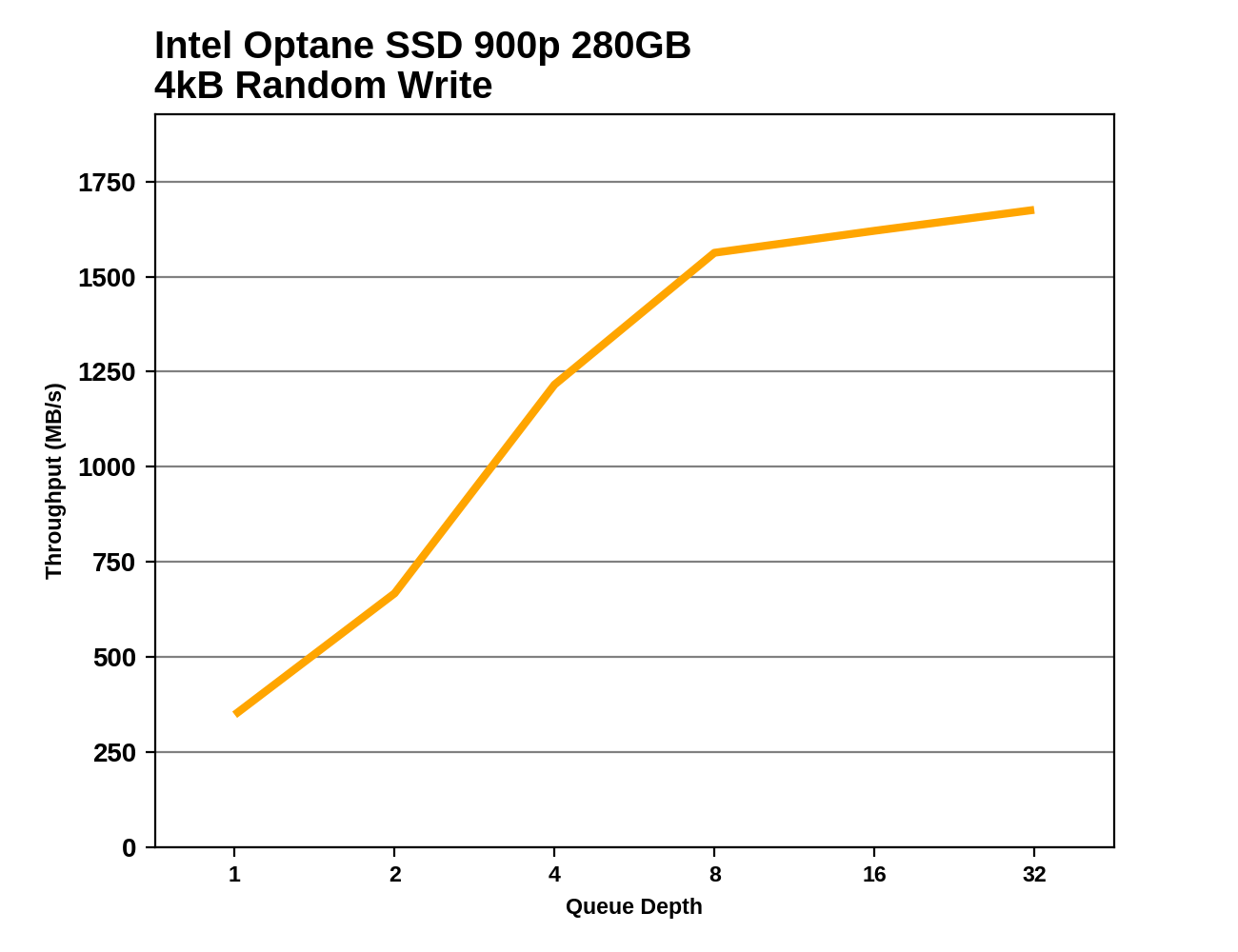 |
|||||||||
Samsung’s 960 PROs and the larger 960 EVO all trail slightly behind the Optane SSD’s random write performance for queue depths 1 to 4, then the Samsung drives level off and leave the Optane SSD with a substantial performance advantage at high queue depths. The Intel 750 is slightly faster at QD1 and QD2, but saturates at an even lower performance level than the Samsung 960s.
Our first test of sequential read performance uses short bursts of 128MB, issued as 128kB operations with no queuing. The test averages performance across eight bursts for a total of 1GB of data transferred from a drive containing 16GB of data. Between each burst the drive is given enough idle time to keep the overall duty cycle at 20%.

The burst QD1 sequential read performance of the Intel Optane SSD 900P falls in between the Samsung 960 PRO and 960 EVO. Samsung’s fastest outperforms the Optane SSD by about 11%.
Our test of sustained sequential reads uses queue depths from 1 to 32, with the performance and power scores computed as the average of QD1, QD2 and QD4. Each queue depth is tested for up to one minute or 32GB transferred, from a drive containing 64GB of data.

On the longer test of sequential read performance, the Optane SSD holds on to a commanding lead after the flash-based SSDs mostly slow down relative to their burst performance.
 |
|||||||||
Both Optane devices show a jump in performance from QD1 to QD2, after which their performance holds steady. Samsung’s 960s show very minor performance increases with queue depth, and at the highest queue depths the Intel SSD 750 comes closest to catching up to the Optane SSD.
Our test of sequential write burst performance is structured identically to the sequential read burst performance test save for the direction of the data transfer. Each burst writes 128MB as 128kB operations issued at QD1, for a total of 1GB of data written to a drive containing 16GB of data.

Samsung’s 960 PRO and EVO drives all outperform the Intel Optane SSD 900P on the burst sequential write test, by up to 16%.
Our test of sustained sequential writes is structured identically to our sustained sequential read test, save for the direction of the data transfers. Queue depths range from 1 to 32 and each queue depth is tested for up to one minute or 32GB, followed by up to one minute of idle time for the drive to cool off and perform garbage collection. The test is confined to a 64GB span of the drive.

On the longer sequential write test, the Optane SSD loses ground to Samsung’s three fastest SSDs but everything else slows down even more.
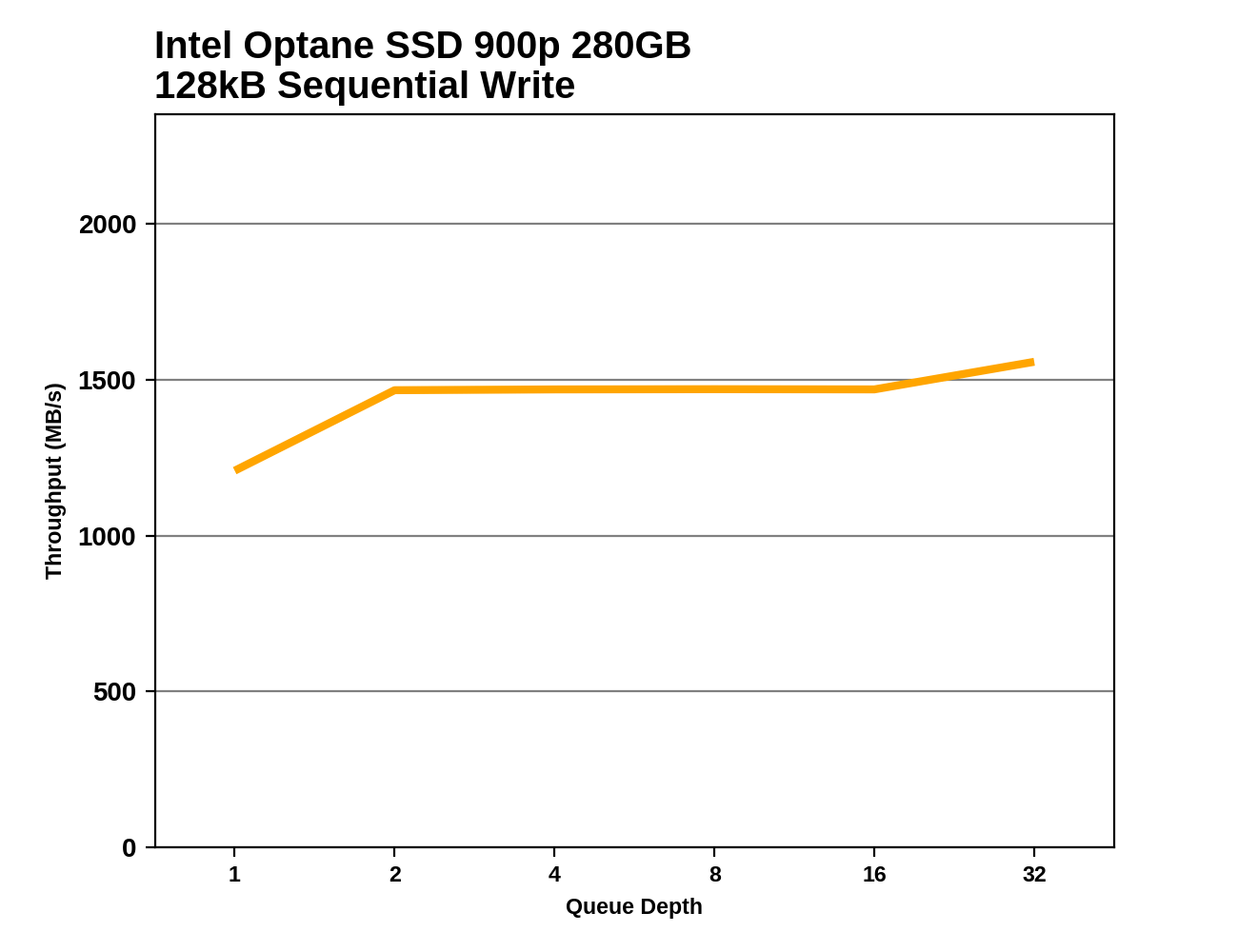 |
|||||||||
Almost all of the SSDs in this bunch reach their full sequential write speed at QD2, and they are mostly differentiated by their speeds once saturated. A few drives show some unevenness during the later portions of the test, but the Optane SSD has just a minor blip in its favor at the end of the test.
Our test of mixed random reads and writes covers mixes varying from pure reads to pure writes at 10% increments. Each mix is tested for up to 1 minute or 32GB of data transferred. The test is conducted with a queue depth of 4, and is limited to a 64GB span of the drive. In between each mix, the drive is given idle time of up to one minute so that the overall duty cycle is 50%.

The mixed random I/O performance of the Intel Optane SSD 900P is completely unmatched. The small Optane Memory M.2 is the second fastest drive we’ve tested, and the fastest flash-based SSD is only a third as fast as the Optane SSD overall.
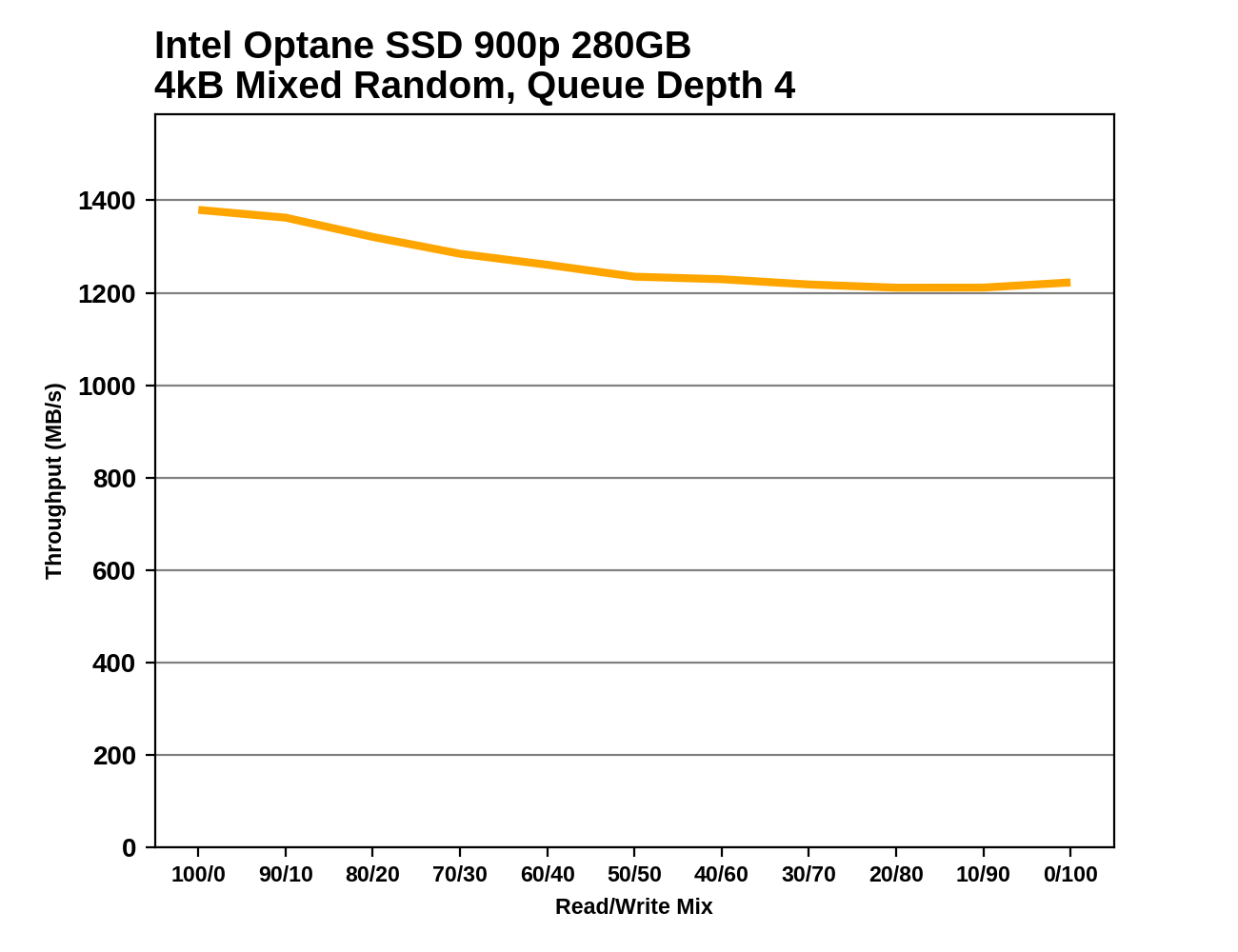 |
|||||||||
At the very end of the test, when the workload shifts to pure random writes, Samsung’s fastest SSDs are able to batch the writes and dramatically improve throughput, almost enough to catch up to the slowest speed the Optane SSD hits during this test.
Our test of mixed sequential reads and writes differs from the mixed random I/O test by performing 128kB sequential accesses rather than 4kB accesses at random locations, and the sequential test is conducted at queue depth 1. The range of mixes tested is the same, and the timing and limits on data transfers are also the same as above.

The Intel Optane SSD 900P doesn’t quite dominate the mixed sequential I/O test to the extent that it trounced the competition in the mixed random I/O test, but it still breaks the record with a 40% higher average throughput than the fastest flash-based SSD.
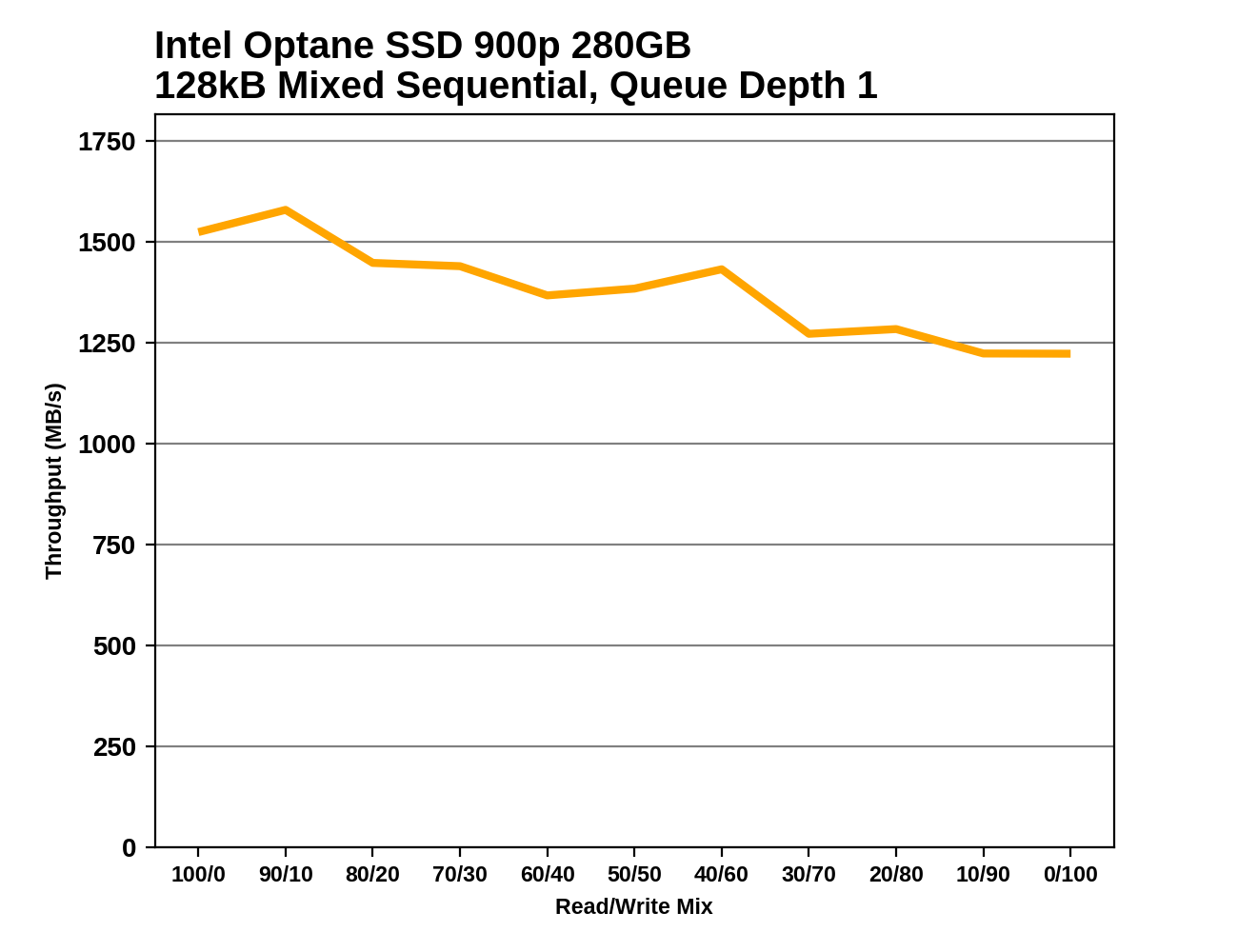 |
|||||||||
The Optane SSD 900P’s performance wavers a bit as the workload changes, but the general trend is a gradual reduction in performance as the proportion of writes increases. The flash-based SSDs tend to show an sharper decline in performance during the first half of the test, and the good ones recover most of that performance over the course of the second half. But the low performance in the middle of the test brings the averages way down and leaves the Optane SSD alone at the top.
BAPCo’s SYSmark 2014 SE is an application-based benchmark that uses real-world applications to replay usage patterns of business users in the areas of office productivity, media creation and data/financial analysis. In addition, it also addresses the responsiveness aspect which deals with user experience as related to application and file launches, multi-tasking etc. Scores are calibrated against a reference system that is defined to score 1000 in each of the scenarios. A score of, say, 2000, would imply that the system under test is twice as fast as the reference system.
SYSmark scores are based on total application response time as seen by the user, including not only storage latency but time spent by the processor. This means there’s a limit to how much a storage improvement could possibly increase scores, because the SSD is only in use for a small fraction of the total test duration. This is a significant difference from our ATSB tests where only the storage portion of the workload is replicated and disk idle times are cut short to a maximum of 25ms.
| AnandTech SYSmark SSD Testbed | |
| CPU | Intel Core i5-7400 |
| Motherboard | ASUS B250-PLUS |
| Chipset | Intel B250 |
| Memory | 2x 8GB Kingston DDR4-2400 CL17 |
| Case | In Win C583 |
| Power Supply | Cooler Master G550M |
| OS | Windows 10 64-bit, version 1703 |
Our SSD testing with SYSmark uses a different test system than the rest of our SSD tests. This machine is set up to measure total system power consumption rather than just the drive’s power.
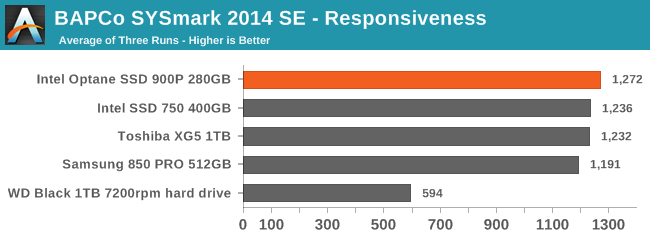
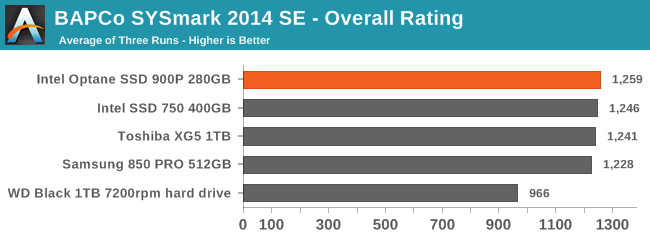
SYSmark 2014 SE doesn’t come close to stressing the storage system enough to show meaningful distinctions between high-end NVMe SSDs. The Responsiveness sub-test is the most sensitive to storage performance, and only shows a few percent difference between most SSDs. The overall test barely registers a difference at all. But with my primary power meter broken, SYSmark does provide a rough assessment of how power hungry the Intel Optane SSD 900P is:
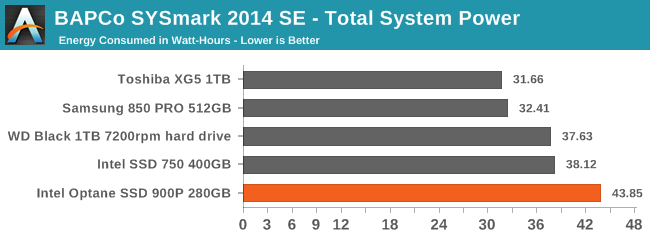
The SYSmark energy usage scores measure total system power consumption, excluding the display. Our SYSmark test system idles at around 26 W and peaks at over 60 W measured at the wall during the benchmark run. SATA SSDs seldom exceed 5 W and idle at a fraction of a watt, and the SSDs spend most of the test idle.
Despite being the fastest drive in this bunch and thus the one with the shortest SYSmark run times, the Optane SSD 900P used far more energy over the course of the three SYSmark runs. With higher idle power than even the Intel SSD 750 and similar power draw under load, the Optane SSD 900P really needs its heatsink. Intel is a very long way off from being able to package this level of performance in a M.2 SSD.
The Intel Optane SSD 900P is an amazing piece of technology, but one whose benefits are difficult to fully enjoy. Its 3D XPoint memory enables it to break almost all the performance records, but some where difference to Optane SSD performance is too small to justify paying more than twice the price per GB. However, there are some scenarios where the Optane SSD absolutely blows away the competition and justifies its premium.
The low queue depth random read performance of the Optane SSD is several times faster than any flash-based SSD has attained. Mixed workloads that include a substantial component of random read operations also perform quite well, and throwing some write operations into a stream of reads barely impacts the read performance.
The Optane SSD 900P has enough space to be used as general-purpose storage, and larger capacity models can be introduced as necessary. There’s no need to tangle with Intel’s caching software and its associated platform lock-in as with the Optane Memory modules.
The biggest problem the Optane SSD 900P faces today is that few desktop users have workloads that stress the storage system enough for the Optane SSD to shine. Mechanical hard drives have not disappeared from use as primary storage, and most software for desktop and workstation use is still designed with their performance limitations in mind. If budget SSDs had relegated hard drives to backup and archival use years ago, then the software landscape would probably be more ready to take advantage of the speed offered by the Optane SSD 900P. Instead, the Optane SSD as a consumer/prosumer product only makes sense in a few niches. Most users- even those with relatively intense storage performance needs – will be better served by high quality flash SSDs like the Samsung 960 PRO.
The price of the Intel Optane SSD 900P is accessible enough that many enthusiasts will pay the premium to have the bragging rights of the fastest SSD money can buy. Workstation users who have massive datasets that don’t fit in RAM will jump at the chance to buy a faster scratch drive. And if that isn’t enough to clear the shelves, then enterprise customers who need high performance but don’t need the extreme write endurance of the Intel Optane SSD DC P4800X can get the 900P with its solid 10 DWPD endurance rating for a third the price per GB. The Optane SSD 900P isn’t for everybody, but it will nonetheless be a successful product, and Intel won’t have any trouble selling them.
The long-term prospects for Intel’s Optane SSDs look pretty good, too. The pricing doesn’t leave Samsung a lot of room to introduce a Z-NAND based consumer SSD. No other alternative nonvolatile memory technology is close to being ready to challenge 3D XPoint. Intel could improve the sequential transfer speeds, but they’re good enough for now. They’ll need to deliver a big jump in performance when they adopt PCIe Gen 4, but that shouldn’t be a challenge: increasing the controller’s channel count from 7 to the 12 channels used by their current NAND flash controller or the 18 used by their first NVMe controller will bring plenty of extra throughput. The only question will then be over the power consumption. The latency is already close to being as low as possible over a PCIe link, and NVDIMMs with 3D XPoint won’t be making Optane SSDs obsolete in the consumer market anytime soon.
In many ways, the performance profile of the Optane SSD is far simpler than that of NAND flash based SSDs. The Optane SSD 900P performs just as well when it is full as when it is almost empty. It performs quite consistently over time, with far fewer high-latency outliers thanks to the lack of garbage collection stalls. Unlike with flash-based SSDs, it is not necessary to buy the largest model to get the highest possible performance; the 280GB model we tested should be very similar to the 480GB model (which we’re waiting for review). It doesn’t matter whether TRIM commands are used, and it’s never necessary to perform a secure erase operation to restore degraded performance.
Intel has almost taken all the fun out of testing a SSD.
Autore: Billy Tallis AnandTech

